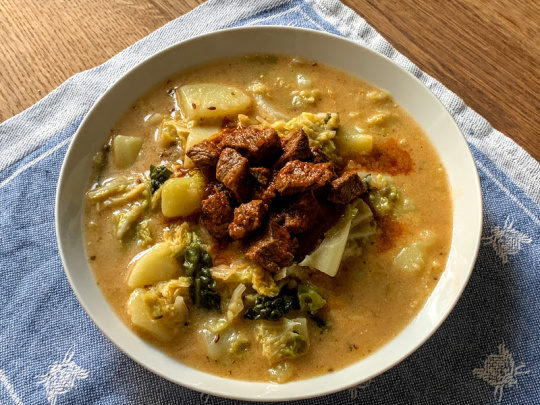
Bits of crinkly Savoy cabbage and potato chunks crowd this creamy and mild vegetable stew flavored with caraway seeds. Using tender new potatos and a few tablespoons of sour cream to finish turn this everyday dish into a luscious treat.
Ingredients
Yield: 4-5 servings; Total time: 30 minutes
1 small head savoy cabbage (about 700 grams or 1 ½ pounds), rinsed, cored, and sliced into bite-sized chunks
4 medium potatoes (600 grams or 1 ⅓ pounds), cut into 2 cm (¾ inch) chunks
2 tablespoons lard or olive oil
1 onion, minced
3 cloves garlic, peeled and minced
1 teaspoon salt
2 teaspoons ground or whole caraway seeds
1 teaspoon fresh or dried marjoram
1 teaspoon Hungarian sweet paprika
2 pinches ground pepper
2 tablespoons sour cream
3 tablespoons flour mixed with ½ cup cold water
Slices of crusty bread
Directions
Step 1: Heat lard or oil in a large pot over medium-high, then add minced onion and sauté until translucent, about 5-6 minutes. Then add minced garlic and sauté for 1 more minute. Then stir in paprika, salt, pepper, caraway seeds, and marjoram, and cover with 1 cup of water and let the mixture simmer for 10 minutes with the lid on.
Step 2: Add the savoy cabbage first then the potato chunks and pour over enough water to almost cover them, about 4 cups. Cook at a simmer until potatoes are soft but not mushy, about 12-15 minutes.
Step 3: Pour the flour slurry (flour mixed with cold water) into the pot and stir well to prevent any lumps. Bring the pot to a brisk simmer for 1-2 minutes, continue stirring, then turn off heat. The stew will start to thicken within minutes. Then add sour cream and stir well.
Step 4: Taste for salt and add more if needed. Serve the savoy cabbage stew in shallow bowls with crusty bread on the side. In Hungary, many people also top the stew with a choice of (pork) goulash, meatballs (fasírt), crisped-up sausages, or fried eggs.
Words of advice
The Savoy cabbage can retain a bitter taste if it's simply steamed rather than cooked in sufficient water; the water helps produce a milder taste.
I created these recipes with the help of nearly a dozen historical Hungarian cookbooks, adjusting ingredients, cooking times, and methods to reflect my own preferences and tastes of the current day. Do you have any feedback? Please let me know!